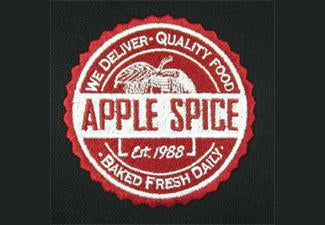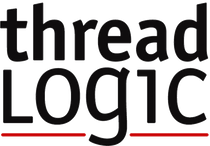Figuring out how much custom embroidery costs can be a complicated process depending on the pricing model. If you're ready to purchase some embroidered logo apparel but aren't sure how to factor in embroidery rates, Thread Logic is here to help! We'll break down the two most common methods for pricing custom logo embroidery, stitch count and flat rate, to give you an idea of typical embroidery costs so you can purchase your branded gear with confidence.
Stitch Count Pricing Method for Embroidery
What is Stitch Count Pricing?
In this method, the embroidery price is determined by the number of stitches it takes to create an image. The reasoning behind this method is: the more stitches it takes, the longer it's on the embroidery machine, and therefore the more it costs.
If your custom embroidery company is using stitch count pricing, you might see something like, “$1 per thousand stitches”. In this formula, a logo with 10,000 stitches would cost $10 to embroider on a shirt. Here's a visual of a high stitch count logo for reference:

What Are the Advantages of Stitch Count Pricing?
Part of the buying decision for customers is figuring out the price of an item. Stich count pricing has some advantages.
- It's an accurate way to cover costs of production for the embroidery shop
- It may cost less to embroider larger logos
- There may be price breaks for larger orders
- The model is fairly standard in the industry
What Are the Disadvantages of Stitch Count Pricing?
Stitch count pricing tends to be more internally motivated, making sure the embroidery company makes a profit, rather than focusing on the customer experience. There are bound to be a few disadvantages when a model is designed for the company over the customer.
- It's very complicated
- Estimates are time-consuming (can take 1-3 days to get a price)
- Customer does not know how many stitches they will need
- It's difficult to estimate the price before production
- There's a lack of transparency with the customer
- It's driven by a cost account philosophy of pricing, not by consumer needs
For example, this is an embroidery pricing description from a competitor’s website:
“Custom embroidered apparel or cap prices include up to 6 colors per logo, up to 10,000 stitches for the 1st logo, and up to 5,000 stitches for additional embroidery locations. $0.35 for every 1,000 stitches exceeding 10,000 stitches, per piece (regardless of quantity purchased).”
What happens if my design has 7 colors in it? How much will this actually cost me? Will we be doing the exact same math? We're in the business and we’re not sure we fully understand how that pricing would work.
Stitch Count Embroidery Pricing Charts
To give you an idea of what stitch count pricing may look like, here's what you might find on an embroidery company's website:
|
|
Quantity of Items |
||||
|
Stitch Count |
1-10 |
11-49 |
50-100 |
100-299 |
300+ |
|
Up to 6000 |
$7.75 |
$4.75 |
$3.50 |
$2.75 |
$2.50 |
|
6000-8000 |
$8.75 |
$5.25 |
$4.00 |
$3.25 |
$2.75 |
|
8000-12000 |
$10.25 |
$5.75 |
$4.50 |
$3.75 |
$3.25 |
|
12000-14000 |
$10.75 |
$6.25 |
$5.00 |
$4.25 |
$3.75 |
Flat Pricing Method for Embroidery
The other pricing method is one that we at Thread Logic have employed since the start of our company. It’s a flat pricing method.
Flat pricing means that the cost for the custom embroidery of a logo is a flat fee and is not dependent on variables like stitch count or number of letters. This makes it much easier for the customer to understand when making a purchasing decision. This is the pricing method we have used at Thread Logic since we first opened our doors in 2002. We even take it one step further; we incorporate the cost of logo embroidery into the item cost you see on our product pages, so there's no room to wonder what you'll be paying for your custom embroidered apparel.
What Are the Advantages of Flat Pricing?
We use flat pricing for a reason. Flat pricing for custom logo apparel takes away all the disadvantages of pricing by stitch count.
- It’s simple and easy to understand
- You won't need to wait for a quote
- There's no need to calculate stitch counts
- It’s a customer-focused pricing model
- The cost of embroidery is transparent
- Logo embroidery costs the same for both small and large orders
- The price you see is the price you pay
What Are the Disadvantages of Flat Pricing?
We’d like to think there aren’t many disadvantages to the flat pricing method, but in the interest of a fair comparison, here’s are some potential cons:
- It's riskier for the embroidery shop
- Logo embroidery costs the same for both small and large orders (this COULD be a disadvantage, too)
The best part is that these disadvantages are offset by the referrals we get for putting our customers first. Flat pricing is one of our best marketing moves. At Thread Logic, we offset the costs of small vs. large orders not by offering you a confusing cheaper rate for larger logos, or on bigger orders based on stitch count. Instead, we support all sizes of businesses and orders, with no minimum order quantity, and quantity discounts starting at orders of just $500.
The flat pricing model is something we have used at Thread Logic from the time we started the company. We get positive feedback from our customers, big and small. It’s one of the best marketing decisions we have ever made. So next time you’re looking to embroider that polo shirt, we hope you choose Thread Logic.

